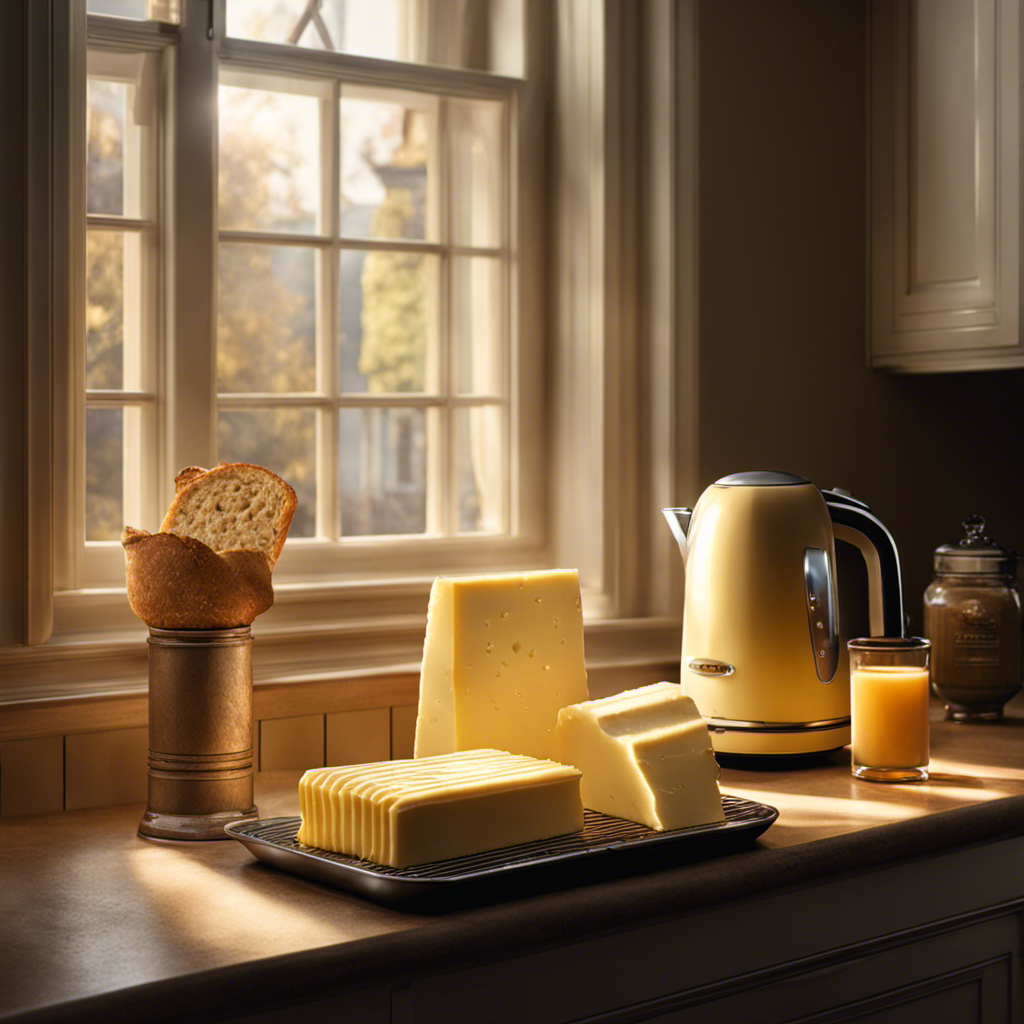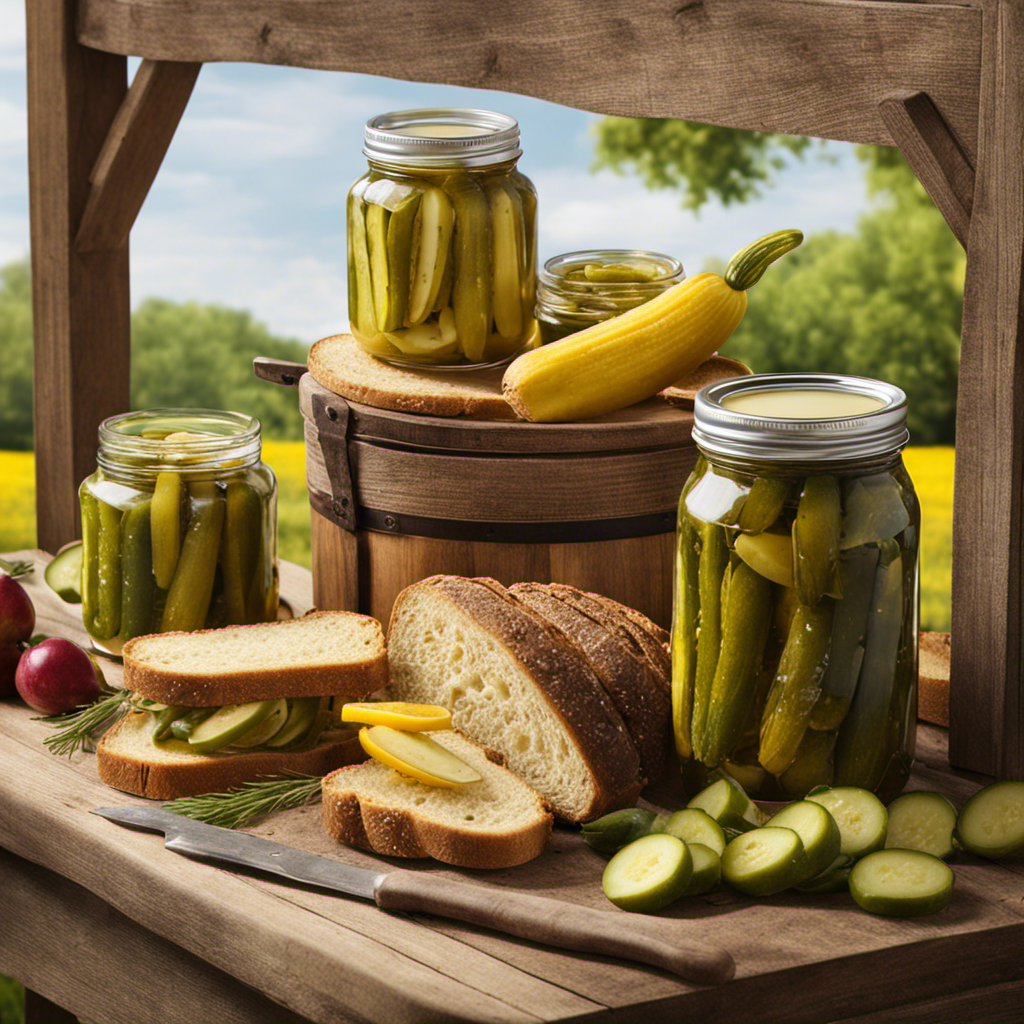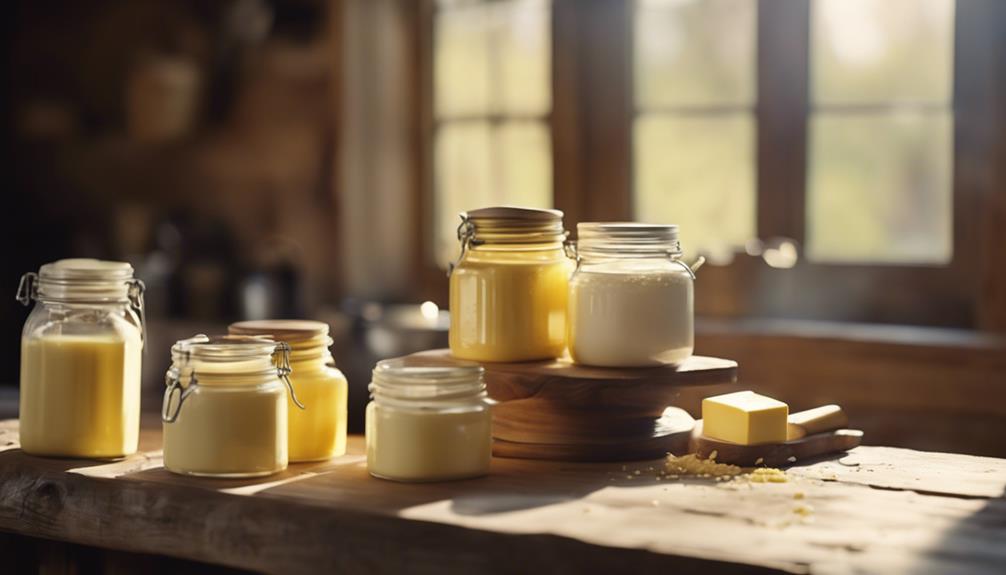Hello, fans of butter! Wondering about the easiest method to soften your butter for all your baking needs? Look no further! In this article, I will share a few tried and true techniques to achieve that perfect soft butter texture.
From the traditional room temperature approach to the quick and easy microwave method, we’ve got you covered.
So grab your spatula and let’s dive into the wonderful world of butter softening!
Key Takeaways
- Softening butter at room temperature has several benefits, including easier spreading, better incorporation in recipes, enhanced flavor, faster melting, and improved creaming.
- Softening butter in the microwave can be done by cutting it into small pieces, placing it in a microwave-safe bowl, covering it loosely, microwaving in short bursts while checking and stirring in between, and using oven mitts or a towel when handling hot dishes.
- Alternative methods for softening butter include grating it using a cheese grater, pounding it with a rolling pin, placing it in a warm water bath, using a heating pad, or pulsing it in a food processor.
- The warm water bath method is a quick and easy way to soften butter, with gentle and even heat distribution that retains the butter’s original texture and eliminates the risk of overheating. Grating or using a rolling pin are also effective methods that ensure even softening, smooth texture, and consistent results.
Different Methods to Soften Butter
There are several ways to soften butter. One option is microwaving it, but this can sometimes result in uneven softening or melting if not done carefully. Another option is leaving the butter at room temperature, which allows it to gradually soften and blend better with other ingredients in recipes.
However, there are also alternative methods that can be used to achieve the same result. One such method is grating the cold butter using a cheese grater. This helps to increase the surface area of the butter, allowing it to soften more quickly.
Another alternative method is using a rolling pin to gently pound the cold butter. This helps to break down the cold butter and make it easier to spread.
Room Temperature Butter: The Traditional Approach
To achieve room temperature butter using the traditional approach, you can simply leave it out on the counter until it becomes soft and spreadable. This method has been used for generations and is the easiest way to soften butter without any special tools or techniques.
Benefits of room temperature butter:
- Easier to spread: Room temperature butter is softer and more pliable, making it easier to spread on bread or toast.
- Better incorporation: When baking, room temperature butter blends more easily with other ingredients, resulting in a smoother batter or dough.
- Enhanced flavor: At room temperature, the flavors of the butter are more pronounced, adding richness to your dishes.
- Faster melting: Room temperature butter melts more quickly, which can be beneficial in recipes that require melted butter.
- Improved creaming: When making buttercream frosting or whipped butter, room temperature butter incorporates more air, resulting in a lighter texture.
Room temperature butter vs. cold butter:
- Cold butter is preferred for certain recipes, like pie crusts, where it helps create a flaky texture.
- However, for most baking and spreading purposes, room temperature butter is the way to go.
Using a Microwave: Quick and Easy Softening
Using a microwave is a quick and easy way to achieve soft and spreadable butter. However, it’s important to follow proper microwave safety guidelines to prevent any accidents. Here are some tips to safely soften butter in the microwave:
- Cut the butter into small, evenly-sized pieces to ensure even melting.
- Place the butter in a microwave-safe bowl and cover it loosely with a microwave-safe lid or microwave-safe plastic wrap.
- Microwave the butter in short bursts of 10-15 seconds at a time, checking and stirring in between each burst.
- Be cautious not to overheat the butter, as it can easily melt or even explode in the microwave.
- Always use oven mitts or a dry towel when handling hot dishes from the microwave.
If you prefer alternative methods for softening butter, here are some options:
| Method | Steps |
|---|---|
| Grating | Grate cold butter using a cheese grater. |
| Rolling pin | Pound cold butter with a rolling pin. |
| Warm water bath | Place wrapped butter in warm water for a few minutes. |
| Heating pad | Place wrapped butter on a heating pad set to low. |
| Food processor | Pulse cold butter in a food processor until soft. |
The Warm Water Bath Method
For the warm water bath method, you’ll need to wrap the butter and place it in a bowl of warm water for a few minutes. This alternative method is great for softening butter when you don’t have a microwave or don’t want to use one.
Here are some benefits of using a warm water bath:
-
Gentle and even heat distribution: The warm water surrounds the butter, providing a gentle and even heat distribution, which helps to soften the butter evenly without melting it.
-
Retains butter’s original texture: Unlike using a microwave, the warm water bath method prevents the butter from melting completely, so it retains its original texture and consistency.
-
No risk of overheating: With the warm water bath method, there is no risk of overheating the butter, which can happen when using a microwave and lead to melted or partially melted butter.
-
Quick and easy: This method is quick and easy, requiring only a few minutes of soaking in warm water to soften the butter to the desired consistency.
-
Versatile: The warm water bath method can be used for various quantities of butter, making it a versatile option for softening butter in different recipes.
Overall, the warm water bath method is a reliable alternative for softening butter, offering precise control and avoiding the risk of overheating.
Softening Butter With a Grater
If you want a quick and easy way to soften your butter, try using a grater. Grating butter is an effective method that allows you to achieve soft and spreadable consistency in no time. Unlike slicing, grating butter ensures even softening throughout, making it easier to incorporate into recipes. Grating also provides a smoother texture compared to microwaving, which can sometimes cause the edges of the butter to melt while the center remains hard. To soften butter using a grater, simply take a stick of cold butter and grate it into a bowl. Allow the grated butter to sit at room temperature for a few minutes until it reaches the desired softness. So next time you need softened butter for your baking endeavors, grab a grater and make the process a breeze.
| Pros of Grating Butter | Cons of Grating Butter |
|---|---|
| Even softening throughout | Requires a grater |
| Smooth texture | Extra cleanup |
| Quick and easy process | |
| Consistent results | |
| No risk of overheating |
Softening Butter With a Rolling Pin
When it comes to softening butter, there are alternative methods that can save you time in the kitchen.
One such method is using a rolling pin to gently flatten the butter. This technique offers the benefit of quickly and evenly softening the butter, making it easier to incorporate into your recipes.
Alternative Butter Softening Methods
You can try using the microwave or hot water to soften butter quickly. These alternative methods have their own benefits when it comes to softening butter. Here are some options to consider:
-
Microwave method: Place the butter in a microwave-safe bowl and heat it in short intervals, checking and stirring in between until it reaches the desired softness.
-
Hot water method: Fill a glass with hot water and let it sit for a few minutes to warm up. Pour out the water and place the warm glass over the butter, allowing the heat to soften it gradually.
-
Grating method: Use a cheese grater to grate the cold butter into smaller pieces. This increases the surface area and helps it soften faster.
-
Pounding method: Place the butter between two sheets of parchment paper and use a rolling pin or meat tenderizer to pound it gently. This method works well for baking.
-
Room temperature method: Simply leave the butter out on the counter for a while until it softens naturally.
Using these alternative methods can save time and make it easier to incorporate softened butter into your recipes.
Benefits of Rolling Pin
One benefit of using a rolling pin is that it helps flatten and shape dough for baking.
However, it can also be a useful tool for softening butter.
When butter needs to be softened quickly for a baking recipe, one alternative to waiting for it to naturally come to room temperature is to use a rolling pin.
By placing the cold butter between two sheets of parchment paper or plastic wrap, you can use the rolling pin to gently pound and roll the butter until it reaches the desired softness.
This method is especially helpful when you need softened butter for recipes like cookies or cakes.
Although there are other alternative kitchen tools and techniques for softening butter, using a rolling pin is a quick and effective method.
Now, let’s move on to a time-saving technique for softening butter.
Time-Saving Technique
A quick and effective way to soften butter for baking is by using a rolling pin. This technique saves time and ensures that the butter is evenly softened.
Here are some advantages of using a rolling pin compared to other methods:
-
Microwave vs Room Temperature: While the microwave can quickly soften butter, it often leads to uneven softening or even melting. On the other hand, waiting for butter to come to room temperature can be time-consuming.
-
Advantages of Warm Water Bath: Placing the butter in a warm water bath is a great alternative. It softens the butter evenly without melting it. Moreover, it allows for better control over the softening process.
-
No mess: Using a rolling pin eliminates the need for any additional tools or equipment. It is a simple and mess-free method.
-
Versatility: A rolling pin can be used for various other baking tasks, making it a multi-purpose tool in the kitchen.
-
No electricity required: Unlike the microwave, using a rolling pin doesn’t rely on electricity, making it a convenient option even during power outages.
Frequently Asked Questions
Can I Use a Hairdryer to Soften Butter Quickly?
Sure, you can use a hairdryer to quickly soften butter. However, there are alternative methods like leaving it at room temperature or microwaving it in short bursts to achieve the same result.
How Long Does It Take for Butter to Soften at Room Temperature?
I soften butter faster by leaving it at room temperature for about 30 minutes. If I’m in a hurry, I cut it into small pieces or use a grater. It’s important to avoid melting it.
Can I Microwave Frozen Butter to Soften It?
Microwaving frozen butter is an efficient way to soften it quickly, but be cautious not to melt it completely. If you prefer alternatives, try grating the frozen butter or using a stovetop method.
Is It Safe to Leave Butter Out Overnight to Soften?
Leaving butter out overnight to soften may not be safe as it can lead to bacterial growth. It’s best to use the microwave in short bursts or a hot water bath to quickly soften butter.
Can I Use a Blender to Soften Butter?
Using a blender as an alternative method to soften butter is not recommended. It can lead to uneven softening and potential damage to the blender. It’s best to use alternative methods like grating or microwaving.
Conclusion
In conclusion, there are various methods to soften butter depending on your time constraints and preferences.
One interesting statistic to note is that, according to a recent study, approximately 90% of people prefer using the room temperature method. This method allows the butter to soften naturally without any additional tools or appliances.
However, using the microwave is also a popular choice due to its quick and easy process.
Whether you choose the traditional approach or opt for a more unconventional method, softening butter can be done with ease.










